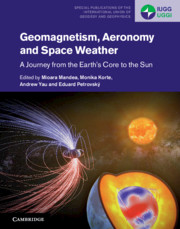Book contents
- Geomagnetism, Aeronomy and Space Weather
- Special Publications of the International Union of Geodesy and Geophysics Series
- Geomagnetism, Aeronomy and Space Weather
- Copyright page
- Contents
- Contributors
- Preface
- Part I Introduction
- Part II Geomagnetic Field
- Part III Spatial and Temporal Variations of the Geomagnetic Field
- 9 Spatial and Temporal Changes of the Geomagnetic Field
- 10 The Global Lithospheric Magnetic Field
- 11 The Ionospheric Field
- 12 The Magnetosphere
- 13 Temporal Field Variations
- Part IV Space Weather
- Part V Magnetic Fields beyond the Earth and beyond Today
- Index
- References
11 - The Ionospheric Field
from Part III - Spatial and Temporal Variations of the Geomagnetic Field
Published online by Cambridge University Press: 25 October 2019
- Geomagnetism, Aeronomy and Space Weather
- Special Publications of the International Union of Geodesy and Geophysics Series
- Geomagnetism, Aeronomy and Space Weather
- Copyright page
- Contents
- Contributors
- Preface
- Part I Introduction
- Part II Geomagnetic Field
- Part III Spatial and Temporal Variations of the Geomagnetic Field
- 9 Spatial and Temporal Changes of the Geomagnetic Field
- 10 The Global Lithospheric Magnetic Field
- 11 The Ionospheric Field
- 12 The Magnetosphere
- 13 Temporal Field Variations
- Part IV Space Weather
- Part V Magnetic Fields beyond the Earth and beyond Today
- Index
- References
Summary
The ionosphere boundary between the magnetosphere and atmosphere is often considered thin in the magnetosphere-ionosphere-thermosphere system. This approximation is not valid at the inner boundary, where height variation is important in ionosphere-thermosphere (I-T) coupling, particularly with respect to momentum/energy transfer. Here the Cowling channel and energy coupling between regions are better modelled including altitude variations. In the equatorial region the equatorial plasma fountain results from a field perpendicular ExB drift and field aligned plasma diffusion, while the equatorial ionisation anomaly is formed by removal of equatorial plasma by upward ExB drift. Under magnetic storm conditions an eastward prompt penetration electric field and neutral winds contribute. The polar cap ionosphere and auroral zones transfer solar wind energy into the magnetosphere. In the polar cap key indicators for energy/momentum transfer to the solar wind I-T system are the cross-polar cap potential/electric field, and the relationship to the interplanetary magnetic field where linear and non-linear relationships may occur. Models have been produced to describe various aspects of the coupled system. In the auroral zones aurora are associated with different regions and processes; substorm-associated aurora, shock associated aurora, pulsation aurora, cusp aurora and mid-latitude aurora. These categories and recent models are referenced.
Keywords
- Type
- Chapter
- Information
- Geomagnetism, Aeronomy and Space WeatherA Journey from the Earth's Core to the Sun, pp. 141 - 159Publisher: Cambridge University PressPrint publication year: 2019

